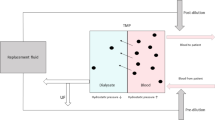Abstract
Continuous renal replacement therapy (CRRT) is used to treat renal failure in children. Despite widespread use of the technique, little research has evaluated how variations in dose of replacement fluid or degree of fluid overload at initiation relate to outcomes. We conducted a retrospective review of patients treated with convective CRRT at our institution, using a multivariable Cox regression model. Children with high fluid overload (>10%) at CRRT initiation were at 3.02 times greater risk of mortality than those with low or no fluid overload [95% confidence interval (CI) 1.50–6.10, P =0.002]. The hazard ratio for death in children treated with high-dose convective clearance was not statistically significant. Our data support previous findings that volume overload in excess of 10% is strongly correlated with poor outcome. We favor early institution of CRRT, before excessive fluid overload occurs. In contrast to findings in adults, we find no advantage to higher rates of convective clearance. Given the risks and increased complexity associated with high-volume hemofiltration, we recommend further study prior to widespread adoption of high-level convection in children treated with continuous veno-venous hemofiltration.



Similar content being viewed by others
References
Ronco C, Ricci Z, Bellomo R (2001) Importance of increased ultrafiltration volume and impact on mortality: sepsis and cytokine story and the role of continuous veno-venous haemofiltration. Curr Opin Nephrol Hypertens 10:755–761
Ronco C, Bellomo R, Homel P, Brendolan A, Dan M, Piccinni P, La Greca G (2000) Effects of different doses in continuous veno-veno hemofiltration on outcomes of acute renal failure: a prospective randomized trial. Lancet 356:26–30
Bouman CSC, Oudemans-van Straaten HM, Tijssen JGP, Zandstra DF, Kesecioglu J (2002) Effects of early high-volume continuous venovenous hemofiltration on survival and recovery of renal function in intensive care patients with acute renal failure: a prospective, randomized trial. Crit Care Med 30:2205–2211
Goldstein SL, Currier H, Graf JM, Cosio CC, Brewer ED, Sachdeva R (2001) Outcome in children receiving continuous venovenous hemofiltration. Pediatrics 107:1309–1312
Goldstein SL, Somers MJG, Symons JM, McAfee N, Bunchman TE, Barnett J, Gregory M, Mottes T, Brophy PD, Feig DI (2002) The first report of the multi-center prospective pediatric continuous renal replacement therapy registry (abstract). J Am Soc Nephrol 13:244A
Pollack MM, Patel KM, Ruttimann UE, Getson PR (1988) Pediatric risk of mortality (PRISM) score. Crit Care Med 16:1110–1116
Acknowledgements
This research was supported in part by a National Research Service Award from the National Institute of Diabetes and Digestive and Kidney Diseases of the National Institutes of Health. The authors gratefully acknowledge Nancy Hawkins McAfee, RN, BSN, CNN, for extensive assistance in data collection and management.
Author information
Authors and Affiliations
Corresponding author
Rights and permissions
About this article
Cite this article
Gillespie, R.S., Seidel, K. & Symons, J.M. Effect of fluid overload and dose of replacement fluid on survival in hemofiltration. Pediatr Nephrol 19, 1394–1399 (2004). https://doi.org/10.1007/s00467-004-1655-1
Received:
Revised:
Accepted:
Published:
Issue Date:
DOI: https://doi.org/10.1007/s00467-004-1655-1




